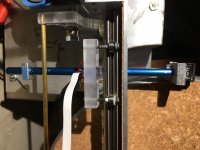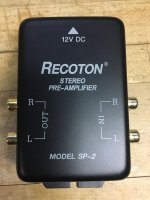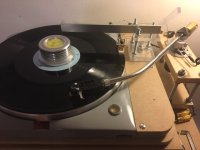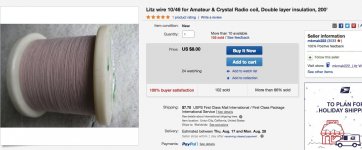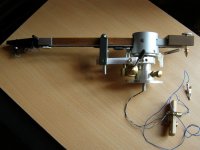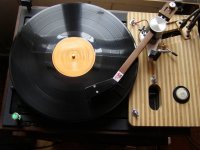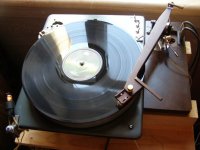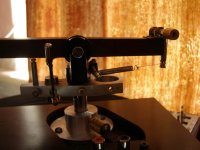My thanks go out to vynuhl.addict for sharing his vision of a DIY tonearm. And also to the rest of the contributors who have added their learning experience and knowledge to the project.
I've been at my version of the arm on and off with ups and downs for about 6 months now, but the last couple months have all been ups and I'm very happy with the results that I'm hearing. And I believe also that I will get more improvements before I'm done being able to be on yourall shirt tails. Now to get a better phono preamp my $12 RadioShack amp isn't worthy of this arm.
So thanks again vynuhl.addict and all.
I've been at my version of the arm on and off with ups and downs for about 6 months now, but the last couple months have all been ups and I'm very happy with the results that I'm hearing. And I believe also that I will get more improvements before I'm done being able to be on yourall shirt tails. Now to get a better phono preamp my $12 RadioShack amp isn't worthy of this arm.
So thanks again vynuhl.addict and all.
Attachments
First, I am not sure what you meant by old records. 2nd, can you post a picture so I can see the construction of your arm?
An externally hosted image should be here but it was not working when we last tested it.
Here is a picture of the arm, i will post som others. But it is all disassembled right now. I have tryed to do all the right things, and also made the arm it self as light as possible. But it just wont play my older records (by old records, i mean the more worn ones. But still absolutely playable on my other turntable)
I am not that strong in english, i hope you understand my problem.
Imo it must be a problem with the arm itself, and not the glass tube, as it is spot on on all the measures. So now i am building a new arm, a little heavy'er. And i have moved the bearings as far from each other as possible, without the axle/bolt touching the glass tube, for more stabillity.
Hope it helps!
Sorry here it is
An externally hosted image should be here but it was not working when we last tested it.
Questions
Here made mine, very nice design with lots of detail, while there are still some challenges hopefully can get advise here,
1. I am using old SME internal wire which is thinner and softer than 33ga, should I use 4x33ga Cardas (a bit ticker thick) or the lizt wire on auction side (30x0.004mm)? I was originally using 36ga silver wire while it's too stiff.
2. Had to lift very tiny bit higher on right side to pass the third hifi-news tracking test, is this normal?
3. Although rare, sometime it jump on groves (with loud record), should I add more weight and keep same tracking force (adding a bit more VTF didn't help).
Here made mine, very nice design with lots of detail, while there are still some challenges hopefully can get advise here,
1. I am using old SME internal wire which is thinner and softer than 33ga, should I use 4x33ga Cardas (a bit ticker thick) or the lizt wire on auction side (30x0.004mm)? I was originally using 36ga silver wire while it's too stiff.
2. Had to lift very tiny bit higher on right side to pass the third hifi-news tracking test, is this normal?
3. Although rare, sometime it jump on groves (with loud record), should I add more weight and keep same tracking force (adding a bit more VTF didn't help).
Attachments
Last edited:
Here made mine, very nice design with lots of detail, while there are still some challenges hopefully can get advise here,
1. I am using old SME internal wire which is thinner and softer than 33ga, should I use 4x33ga Cardas (a bit ticker thick) or the lizt wire on auction side (30x0.004mm)? I was originally using 36ga silver wire while it's too stiff.
2. Had to lift very tiny bit higher on right side to pass the third hifi-news tracking test, is this normal?
3. Although rare, sometime it jump on groves (with loud record), should I add more weight and keep same tracking force (adding a bit more VTF didn't help).
Hi,
1. I tried a litz cable that is probably the same as the one you mention and found it to be both too heavy and not flexible enough. (i think it's 30 x 0.04mm) After much experimentation, I've probably tried a dozen different cable configurations, I found what worked best for my arm. I'm currently using 0.08mm transformer wire. I use 4 strands per channel twisted together with 2 strands for positive and 2 for negative. I tried just using a single strand per conductor but the sound became slightly thin. There was no discernable improvement in using 3 strands over 2, the cable just became stiffer. I also found that 2 strands per conductor of 0.08mm works better than a single strand of 0.112mm. The cable with the 0.112mm has about the same cross sectional area but is much stiffer.
2. Ideally the rail should be absolutely horizontal. Tilting the rail will have the effect of reducing the effect of lateral friction when tracking to the left. Unfortunately most records are not perfectly concentric so the carriage has to constantly move left and right. Tilting the rail effectively increases friction when tracking to the right. You will also find that VTA will vary across the record.
3. It is highly likely that the reason that you are having trouble with skipping on loud passages is connected to why you had to tilt the rail. You are probably more likely to skip due to dust as well. The reason is that your bearing friction is too high. Increasing carriage mass will probably make matters worse as it will increase friction. Are you using dry bearings? Any oil or grease will increase friction dramatically. If you haven't already try washing the bearings in acetone. The quality of the bearings used makes a huge difference. You can get away with cheap ball races from an RC shop but you will probably end up with worse lateral tracking error than you get from a standard 9" arm. I highly recommend using the silicon nitride hybrid bearings from Boca bearings. These are supplied dry so you don't have to wash them. I built a measurement rig to measure the actual level of friction for different bearings. The Boca hybrids had about 60% the friction of some Chinese full zirconium oxide ceramic bearings that I tried. The Chinese bearings are almost certainly much better than standard grade bearings, I haven't measured standard grade bearings so I can't say how much better. The Boca are not cheap but are IMO definitely worth the extra. (No affiliation)
I hope this helps.
Niffy
Last edited:
Thanks Niffy!
I am using RC ceramic ball bearing washed with lacquer thinner then acetone.
Regarding Boca, I selected 3x10x4, Si3N4, LD, then the rubber sealing, only single model popped, hopefully this is the one you are using,
https://www.bocabearings.com/products/smr103c-2os-p58-7-ld-17940
Description
Stainless Steel, Ceramic Hybrid, Orange Sealed bearings are specially designed for any application seeking a high precision, free spinning bearing. These are the true secret weapon for serious rc racers and long distance casters. ABEC 7 tolerances makes the Orange Seal line the closest precision tolerance that Boca Bearings has to offer. The removable, non-contact rubber seals results in a bearing with less drag and that requires less maintenance than a typical shielded bearing. The Grade 5 ceramic Si3N4 balls will allow the bearing to be lighter and spin 50% faster than a traditional steel bearing. LD = Lube Dry Bearings have been clean and are free of all grease and Oils. SMR103C-2OS/P58 #7 LD (3x10x4)
I am using RC ceramic ball bearing washed with lacquer thinner then acetone.
Regarding Boca, I selected 3x10x4, Si3N4, LD, then the rubber sealing, only single model popped, hopefully this is the one you are using,
https://www.bocabearings.com/products/smr103c-2os-p58-7-ld-17940
Description
Stainless Steel, Ceramic Hybrid, Orange Sealed bearings are specially designed for any application seeking a high precision, free spinning bearing. These are the true secret weapon for serious rc racers and long distance casters. ABEC 7 tolerances makes the Orange Seal line the closest precision tolerance that Boca Bearings has to offer. The removable, non-contact rubber seals results in a bearing with less drag and that requires less maintenance than a typical shielded bearing. The Grade 5 ceramic Si3N4 balls will allow the bearing to be lighter and spin 50% faster than a traditional steel bearing. LD = Lube Dry Bearings have been clean and are free of all grease and Oils. SMR103C-2OS/P58 #7 LD (3x10x4)
Last edited:
I believe the model I used is SMR103C-ZZ #7 LD Wichita is abec 7 and supplied unlubricated. I purchased mine quite a few years ago and don't have an exact record. If I remember correctly I paid about $50, including postage from the States to the UK, for a pair. Avec 7 might be better than 9 in this application as the greater amount of play may aid vertical pivoting
Niffy
Niffy
Thanks again! That's metal shield, is that easy to be removed same as rubber shield?
SMR103C-ZZ #7 LD
3 X 10 X 4 MILLIMETERS
0 Reviews
Description
Stainless Ceramic, Metal Shields, Grade 5 Si3N4 Ceramic Balls, C3 Fit, ABEC #7, Lube Dry, SMR103C-ZZ #7 LD (3x10x4) MM
SMR103C-ZZ #7 LD
3 X 10 X 4 MILLIMETERS
0 Reviews
Description
Stainless Ceramic, Metal Shields, Grade 5 Si3N4 Ceramic Balls, C3 Fit, ABEC #7, Lube Dry, SMR103C-ZZ #7 LD (3x10x4) MM
litz/magnet wire
regarding the magnet/litz wire, I found this one hopefully the copper is good and soft
regarding the magnet/litz wire, I found this one hopefully the copper is good and soft
Attachments
Last edited:
Thanks again! That's metal shield, is that easy to be removed same as rubber shield?
SMR103C-ZZ #7 LD
3 X 10 X 4 MILLIMETERS
0 Reviews
Description
Stainless Ceramic, Metal Shields, Grade 5 Si3N4 Ceramic Balls, C3 Fit, ABEC #7, Lube Dry, SMR103C-ZZ #7 LD (3x10x4) MM
My mistake. The bearings I purchased had the rubber seals and were easy to remove.
Niffy
2a3
That looks like the same spool of litz I have had for 20+ years.
If so, and its from New England wire, it is very flexible and requires more heat than say, Cardas tonearm wire, but is slightly more flexible due to the cloth sheath.
Regards
David
That looks like the same spool of litz I have had for 20+ years.
If so, and its from New England wire, it is very flexible and requires more heat than say, Cardas tonearm wire, but is slightly more flexible due to the cloth sheath.
Regards
David
Since linear tonearms has neither offset angle nor a pivot so should present a constant bearing friction in both ways if tonearm is leveled horizontally. So a slight tilt should not pose a problem. Right ?
Regards
Regards
How about we use insulated tonearm wire and remove insulation just at the bend where it is routed in tonearm ?
regards
regards
Is that orange rubber?
Probably the same I found, as it's the only one meet those criteria, SMR103C-2OS/P58 #7 LD
Probably the same I found, as it's the only one meet those criteria, SMR103C-2OS/P58 #7 LD
My mistake. The bearings I purchased had the rubber seals and were easy to remove.
Niffy
I used wires from a pair of broken Sennheiser 600 headphone wire. It is basically magnet wires and about 40 AWG. I used three strands of wires for each signal path. I laid three wires together and tapped both ends. Then, hold one end of the wires and attach other end to a power drill. Start the power drill slowly while keeping the wire straight. It works very well.
Thanks Niffy! Got the boca bearing SMR103C-2OS/P58 #7 LD BG (3X10X4) MM with orange seal, all problem resolved, no need to tilt anymore, and no skipping!
My mistake. The bearings I purchased had the rubber seals and were easy to remove.
Niffy
Thanks Niffy! Got the boca bearing SMR103C-2OS/P58 #7 LD BG (3X10X4) MM with orange seal, all problem resolved, no need to tilt anymore, and no skipping!
Excellent news. Glad I could help.
Niffy
I haven't heard a high quality arm that uses a spring counterbalance so cannot comment on sound quality. I know a lot of people swear by them so there may be something to them. However some people swear by snake oil so who knows. I think that the addition of a spring is inevitably going to add a resonance and I can't see how that is a good thing unless there is a benefit that outweighs it.
Niffy[/QUOTE]
Actually, spring counterweight arm has much less parasitic resonances, as a result less prone to acoustical feedback and rumble. Yes, spring counterweight disappears from hi-fi tonearmes in the middle of last century, completely replaced with gravitational weights. That doesn't mean it is better at all. I did some experiments with springs, and to great surprise the same arm ( weight being substituted with spring) has 10 to 30 dB less rumble and acoustical feedback noise. See some pics. Sorry, both are not linear arms,the last is my DIY, and I like how it works. First arm is LAB-80 Garrard, with spring instead of weight, second is my DIY.
I would like to see spring implemented on linear arm, I'm sure it is worthy for trials.
Niffy[/QUOTE]
Actually, spring counterweight arm has much less parasitic resonances, as a result less prone to acoustical feedback and rumble. Yes, spring counterweight disappears from hi-fi tonearmes in the middle of last century, completely replaced with gravitational weights. That doesn't mean it is better at all. I did some experiments with springs, and to great surprise the same arm ( weight being substituted with spring) has 10 to 30 dB less rumble and acoustical feedback noise. See some pics. Sorry, both are not linear arms,the last is my DIY, and I like how it works. First arm is LAB-80 Garrard, with spring instead of weight, second is my DIY.
I would like to see spring implemented on linear arm, I'm sure it is worthy for trials.
Attachments
Last edited:
Dual turntables had springs in their bearing along with counterweight. may be that is also a good approach.
Hi Walterwalter,
The implementation of a spring counterbalance in a pivoted tonearm is pretty straightforward as the spring connects between the arm stub (where the counterweight would normally be) and the bearing yoke, both of which rotate together. In a linear design where do you connect the lower end of the spring? The only solution that springs to mind (pardon the pun) would be to split the carriage into two parts, similar to the souther. The lower part of the carriage would have to run on dual rails to prevent it from tilting. A separate vertical pivot would then connect the two parts of the carriage with the counterbalance spring linked between them. This approach would substantially increase the mass of the carriage (by a lot more than that saved by removing the counterweight). To reduce this the whole arm would have to be insubstantial in its construction which would inevitably make it less rigid. In this approach you would loose a lot more than you gain.
Is there a way of implementing a spring counterbalance to a single piece carriage?
Niffy
The implementation of a spring counterbalance in a pivoted tonearm is pretty straightforward as the spring connects between the arm stub (where the counterweight would normally be) and the bearing yoke, both of which rotate together. In a linear design where do you connect the lower end of the spring? The only solution that springs to mind (pardon the pun) would be to split the carriage into two parts, similar to the souther. The lower part of the carriage would have to run on dual rails to prevent it from tilting. A separate vertical pivot would then connect the two parts of the carriage with the counterbalance spring linked between them. This approach would substantially increase the mass of the carriage (by a lot more than that saved by removing the counterweight). To reduce this the whole arm would have to be insubstantial in its construction which would inevitably make it less rigid. In this approach you would loose a lot more than you gain.
Is there a way of implementing a spring counterbalance to a single piece carriage?
Niffy
- Home
- Source & Line
- Analogue Source
- DIY linear tonearm

